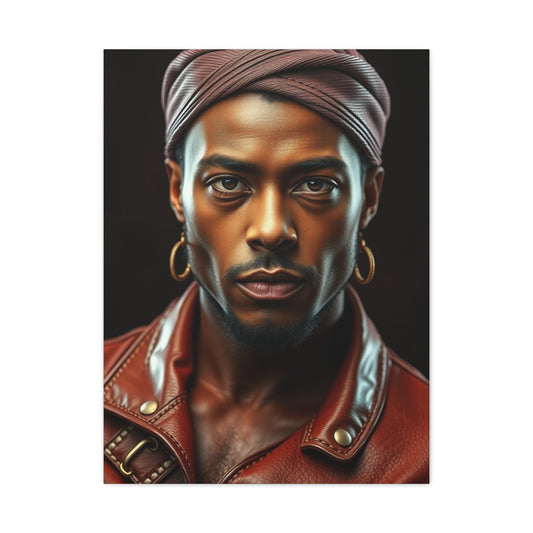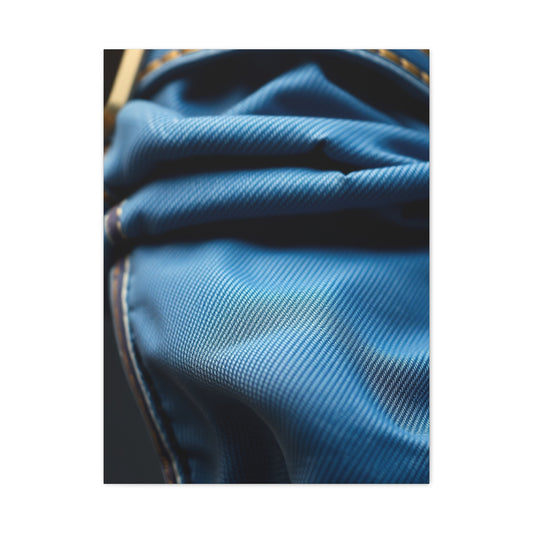Denim & Leather: Transforming Spaces with Textured Wall Art
Denim has always been more than just a fabric. It is a textile that transcends trends, symbolizing resilience, versatility, and cultural identity. At any given moment, a vast portion of the world’s population is wearing jeans, making denim one of the most universally recognized and worn materials. Each year, billions of pairs are produced, underscoring its dominance not only in fashion but also as a cornerstone of global commerce. Beyond its commercial significance, denim resonates emotionally, representing both everyday functionality and a sense of style.
This ubiquity has allowed denim to seep into unexpected corners of our lives, no longer limited to wardrobes or streetwear culture. The natural progression of a material so integral to human expression has been its adaptation into interior spaces. In recent years, designers and homeowners alike have discovered denim’s potential as an unconventional yet sophisticated design element for interiors, proving its narrative has only just begun.
The Early Uses of Denim and Their Design Implications
Before denim ever became the staple of casual fashion, it served a far more utilitarian purpose. In the nineteenth century, it was deployed in wagon covers, tents, and horse blankets. Its tightly woven cotton structure offered durability and resistance against harsh outdoor elements. This heritage of endurance has inspired today’s interior designers to incorporate denim into spaces where longevity and texture are valued.
By tracing denim back to its industrial roots, we begin to understand its ability to harmonize rugged functionality with aesthetics. Upholstered chairs, benches, and sofas wrapped in denim mimic the practical sturdiness once demanded by pioneers while simultaneously introducing a tactile warmth. The resonance of this history enriches interiors by giving them not only a visual appeal but also a deeper material narrative.
Crafting Narrative Through Furniture
In any interior setting, furniture operates as the central anchor of the design story. Denim, with its strong cultural associations, introduces layers of meaning when used in upholstery or structural accents. A chair covered in denim does not merely serve as a seat but also becomes a statement — one that speaks of durability, rebellion, and craftsmanship.
Designers have tapped into this duality by creating pieces that nod to denim’s working-class origins while elevating it into refined spaces. For instance, a dining chair upholstered with indigo denim immediately invokes a sense of familiarity yet feels fresh when placed against polished wood or marble. This juxtaposition bridges tradition and modernity, capturing the imagination of those who seek interiors rich in both comfort and narrative depth.
The Birth of Jeans and Their Evolution
To fully appreciate denim’s migration into interiors, one must revisit the birth of jeans. During the Californian Gold Rush of the 1800s, laborers needed trousers that could endure arduous physical work. Jacob Davis, a skilled tailor, responded to this need by reinforcing denim trousers with rivets, creating an innovation that would alter the history of clothing. By partnering with Levi Strauss, he helped establish the blueprint for jeans as we know them today.
From that moment, jeans evolved far beyond their utilitarian roots. They became cultural markers — first as the attire of workers, later as symbols of rebellion in mid-twentieth-century cinema, and eventually as universal wardrobe essentials. This constant reinvention provides a parallel to their adaptation in interiors, where denim once again morphs to suit shifting demands while retaining its timeless appeal.
Experimental Furniture Design with Denim
Contemporary designers continue to experiment with denim in furniture by blending traditional craftsmanship with modern innovation. By recycling old jeans, coating them with resin, and shaping them through thermosetting processes, artisans create lightweight stools and side tables that blur the line between textile and sculpture. These pieces maintain the fabric’s recognizable grain and indigo hue, but their tactile surface is transformed into something simultaneously familiar and avant-garde.
Such experimentation not only extends denim’s lifecycle but also aligns with sustainable design philosophies. Denim, often discarded after years of wear, can be repurposed to live on within interiors. The transformation from clothing to furniture embodies the concept of material resilience, giving old textiles renewed purpose while reducing waste.
Denim as a Cultural Symbol in Spaces
Throughout its journey, denim has remained deeply symbolic. Once tied to blue-collar workers, it later represented defiance, youth culture, and individuality. In modern interiors, these cultural associations lend emotional resonance to the spaces denim inhabits.
For example, a bathroom vanity constructed with denim-inspired finishes invokes a sense of nostalgia while presenting a playful yet stylish interpretation of everyday clothing. Stitching details on drawer fronts echo the seams of a well-loved pair of jeans, while metallic accents mirror the rivets that hold pockets together. These subtle references weave storytelling into design, allowing spaces to resonate beyond their functional roles.
The Chromatic Power of Indigo
The color of denim itself — a spectrum of indigo blues that fades and transforms with wear — is perhaps its most powerful attribute. Indigo hues are calming, grounded, and evocative of natural elements like sky and sea. When incorporated into interiors, these tones create a serene atmosphere while carrying the depth of denim’s cultural weight.
Designers often use tonal variations of denim blue to construct harmonious palettes. From deep navy to pale, sun-washed shades, these colors bring dimension to walls, upholstery, and accents. Their adaptability makes them suitable for a variety of interior moods, from rustic and relaxed to sleek and contemporary. Unlike more transient color trends, indigo retains its timeless quality, ensuring spaces feel both current and enduring.
The Tactile Appeal of Denim Surfaces
Texture is a critical aspect of design, and denim offers an unmistakable tactile quality. Its weave, grain, and ability to fray with use introduce an organic, lived-in feeling. When translated into interior finishes, this tactility softens hard surfaces and injects character into neutral spaces.
Tiles designed to resemble denim, for instance, bring a textile-like softness to floors and walls. Their subtle sheen and irregular surface structure replicate the nuanced feel of fabric. Whether in a bathroom, kitchen, or lounge area, these tiles surprise the senses by merging the visual familiarity of denim with the durability of ceramic or porcelain. Such material playfulness challenges conventional design expectations, encouraging occupants to interact with their environment in new ways.
Global Influences on Denim Design
Denim’s global journey has also shaped its interior applications. Japan, known for its meticulous approach to textile weaving and dyeing, produces some of the world’s most revered denim. The Japanese emphasis on thickness and texture makes their fabrics highly durable and richly expressive.
In interior design, Japanese denim translates into robust upholstery and striking statement pieces. A plush indigo sofa in a loft, paired with minimalist architecture, demonstrates the fusion of heritage craftsmanship with contemporary living. Additionally, wall art crafted from repurposed denim textiles showcases creativity while honoring the cultural legacy of Japanese artisanship. This cross-cultural adaptation underlines denim’s universal relevance and its ability to transcend geographic boundaries.
Sustainable Design and Denim Recycling
Sustainability is a pressing concern in today’s design landscape, and denim offers ample opportunities for creative recycling. Worn-out jeans that might otherwise be discarded can be repurposed into pillow covers, upholstery patches, or wall hangings. By extending the life of denim, designers and homeowners participate in a cycle of reuse that honors the material’s durability while minimizing environmental impact.
Do-it-yourself enthusiasts often find joy in transforming old denim into home accessories. A faded jacket can become a pillowcase, while fabric remnants may serve as trims for curtains or cushions. These projects imbue interiors with personal history and individuality, making spaces feel authentic and emotionally connected to their occupants.
Emotional Resonance of Denim in Interiors
Perhaps what sets denim apart in interior design is its emotional resonance. Few materials carry such widespread familiarity and personal association. Nearly everyone has owned a pair of jeans that bore witness to significant moments of life, from youthful adventures to everyday routines. Bringing denim into interiors allows people to embed those memories into their surroundings, creating homes that feel both deeply personal and universally relatable.
A faded denim cushion on a sofa, for instance, does more than add texture and color; it evokes the comfort of a beloved garment. In this way, denim bridges fashion and home, offering a continuity of self-expression across different aspects of daily living.
Denim’s trajectory from utilitarian workwear to global fashion icon and now to a celebrated interior design material demonstrates its extraordinary adaptability. As a textile, it carries layers of history, culture, and symbolism, making it an ideal candidate for storytelling within spaces. Through furniture, finishes, colors, and upcycled projects, denim enriches interiors with durability, character, and emotional depth.
Its ability to straddle both tradition and innovation ensures that denim will continue to inspire new interpretations in design. Whether in the form of indigo-hued tiles, recycled furniture, or handcrafted upholstery, denim remains a fabric that connects people to their past while offering fresh possibilities for the future of interiors.
Denim Interiors: From Cultural Icon to Contemporary Design
Denim’s story is not confined to clothing alone. Its transformation over the centuries mirrors cultural evolution itself. Emerging first as a practical textile woven for strength, it gradually became the signature of miners, farmers, and laborers who valued its ability to withstand punishing conditions. But by the mid-twentieth century, denim had shifted from sheer utility to cultural iconography. Worn by actors, rebels, musicians, and innovators, it became a symbol of independence and identity.
This layered history gives denim its rich context when introduced into the world of interiors. Every stitch, weave, and shade carries echoes of its long-standing cultural associations, offering designers a palette that is not only visual but also narrative-driven. Bringing denim indoors allows a home to inherit these meanings, layering the space with subtle but powerful storytelling.
The Emotional Appeal of Denim in Homes
One of the strongest reasons denim translates so effectively into interiors is its universal familiarity. Almost every person has memories tied to a favorite pair of jeans: perhaps worn during adolescence, perhaps kept for years despite frays and tears, perhaps handed down from one generation to the next. Denim carries sentiment embedded in its fibers, a record of lived experiences that few other textiles embody.
When these memories are woven into interior spaces, they create a resonance that extends beyond aesthetics. A faded denim pillow, a chair upholstered in indigo, or tiles designed to mimic the softness of fabric bring comfort and warmth, echoing the emotional qualities of well-loved garments. This blend of sentiment and style elevates denim beyond design; it becomes a medium of personal expression inside the home.
Indigo as a Design Language
Color plays a pivotal role in interiors, and denim’s indigo hue remains its most distinctive quality. This particular shade of blue has a dynamic ability to transform spaces, from creating serenity in bedrooms to lending richness in living rooms. Its tonal variations — ranging from the deepest navy to the softest sky-washed blue — allow it to adapt across diverse design aesthetics.
Unlike fleeting color fads, indigo maintains a timelessness rooted in history. For centuries, natural indigo dyeing has been celebrated in cultures around the world, valued for its depth and durability. In modern interiors, the application of indigo reflects both continuity and innovation. Designers use it not only in wall paints and textiles but also in tiles, cabinetry, and even bathtubs, where the effect is simultaneously grounding and striking.
Denim-Inspired Furniture: A New Aesthetic Frontier
Furniture upholstered in denim does more than introduce a casual, tactile quality to interiors; it reshapes the perception of what is possible with textiles. Designers experiment with structured sofas, accent chairs, and ottomans wrapped in sturdy denim, bringing an unconventional yet stylish energy to spaces.
Beyond upholstery, designers reimagine denim by layering it with techniques usually reserved for industrial design. By applying resins, heating methods, or laminations, denim can be transformed into sculptural stools, tables, and even lighting elements. These pieces carry a raw authenticity, where the original weave and texture of the fabric are visible, but their function is reinvented. The balance of familiarity and novelty makes them conversational anchors in any room.
The Influence of Cinema and Pop Culture on Denim Interiors
Denim’s leap from workwear to cultural emblem was accelerated by its cinematic and musical associations. Films of the 1950s, with icons like James Dean and Marlon Brando clad in denim, forever linked the fabric with rebellion, youthful defiance, and freedom. In the decades that followed, denim remained a fixture in music culture, from rock and punk to hip-hop, symbolizing individuality and nonconformity.
When denim enters interiors, it carries these cultural echoes. A wall clad in denim-textured tiles, for example, does not merely display a pattern; it evokes entire decades of cultural memory. A sofa covered in washed indigo references not only fashion but also film and music history. This interplay of memory and material enriches interiors, turning them into multidimensional experiences rather than static environments.
Denim in Bathrooms and Kitchens
Bathrooms and kitchens, often defined by cold surfaces like stone, ceramic, or steel, are now being warmed with denim-inspired designs. Vanity units with visible stitching and rivet-like handles mimic the design of jeans, adding a playful and humanized quality to functional spaces. Tiles with denim textures bring softness to walls and floors, creating visual intrigue without compromising durability.
Even bathtubs have embraced the denim aesthetic. Some feature outer shells wrapped in denim-like finishes, offering a tactile and unexpected twist. This blending of textile-like qualities with hard materials exemplifies how denim challenges design conventions, making practical rooms feel more personal and characterful.
Global Perspectives: Japanese Denim in Interiors
Japanese denim holds a revered place among enthusiasts for its thickness, durability, and artisanal quality. Japan’s long history of textile weaving and dyeing has cultivated a denim tradition that emphasizes craftsmanship over mass production. This meticulous approach has translated seamlessly into interiors.
Japanese denim-inspired sofas, wall panels, and accent pieces combine precision with artistry. Their weight and weave offer both visual depth and physical resilience, making them long-lasting additions to a home. Moreover, repurposed denim artworks and textiles align with Japan’s philosophy of finding beauty in imperfection, where fading, fraying, and patina are celebrated rather than concealed. Such interiors embody a philosophy that values authenticity and time’s imprint on materials.
Denim as a Sustainable Interior Choice
Sustainability is increasingly at the forefront of design thinking, and denim provides fertile ground for eco-conscious creativity. Millions of pairs of jeans are discarded each year, yet their sturdy cotton fabric remains usable. Repurposing this material for interiors aligns with principles of reuse and upcycling, reducing waste while generating distinctive design pieces.
From handcrafted pillows and cushions to wall hangings and rugs, denim recycling introduces individuality to interiors. Each piece carries unique fades and wear patterns, ensuring no two items are identical. This uniqueness adds character and emotional depth to homes, resonating with the growing desire for personalized environments.
For large-scale interiors, denim remnants can even be applied to panels or acoustic boards, offering both functionality and aesthetic appeal. Such innovations highlight how denim’s material qualities extend far beyond clothing, positioning it as a forward-looking resource in sustainable design.
The Tactile and Textural Dimension
In design, texture often influences the way a space feels as much as how it looks. Denim offers a tactile richness that other fabrics cannot easily replicate. Its tight weave, subtle grain, and ability to age gracefully bring layered character to interiors. As it wears, denim reveals lighter undertones, frayed edges, and softened surfaces, all of which create warmth and authenticity.
When applied to upholstery, cushions, or wall art, denim adds a lived-in familiarity that contrasts beautifully with sleek, polished materials like glass or steel. This tactile juxtaposition prevents interiors from feeling sterile, infusing them instead with comfort and relatability.
Denim’s Role in Personal Expression at Home
Homes are extensions of identity, and denim offers a medium through which people can express individuality. Just as jeans are chosen in different cuts, washes, and fits to reflect personal style, denim interiors allow customization through color variations, finishes, and creative adaptations.
Some prefer deep, dark indigo upholstery that evokes sophistication, while others lean toward sun-faded denim pillows that suggest ease and nostalgia. By layering denim accents with wood, metal, or natural stone, interiors can reflect a wide range of personalities, from rustic and casual to urban and refined. This adaptability ensures denim remains not only relevant but also deeply personal in every context.
Emotional Continuity Across Fashion and Interiors
Denim’s transition from wardrobe to home represents more than a shift in use; it embodies emotional continuity. The same qualities that make a pair of jeans beloved — comfort, resilience, adaptability — are seamlessly translated into interiors. This continuity fosters a sense of coherence in lifestyle, where clothing and living spaces reflect the same values of authenticity and timelessness.
By surrounding themselves with denim-inspired designs, individuals bring fragments of their personal histories into their homes. Each fade, seam, or rivet-inspired detail connects daily living to the broader cultural narrative of denim. In this sense, homes become not only spaces for living but also canvases for storytelling.
The journey of denim from workwear to cultural icon and now to interior mainstay reveals its unmatched versatility. In interiors, it offers more than mere aesthetic appeal; it provides history, symbolism, and sustainability. From indigo palettes to repurposed textiles, from experimental furniture to Japanese craftsmanship, denim enriches homes with narrative depth and tactile comfort.
Its ability to unite practicality with emotion ensures its enduring relevance. As denim continues to evolve within interiors, it will remain a fabric that transcends boundaries, bridging fashion, culture, and design in ways both familiar and refreshingly unexpected.
Denim Interiors: The Fabric of Memory and Modernity
Denim’s enduring allure lies not only in its strength but also in its ability to evolve over time. Unlike synthetic textiles that strive for permanence, denim embraces imperfection. Its surface softens, fades, and acquires unique markings that record the life it has lived. This quality, often described as patina, makes denim especially suited for interiors that aim to feel authentic and personal rather than sterile or contrived.
When a denim-upholstered sofa develops subtle variations in color from use, or a cushion made from repurposed jeans shows delicate fraying at the seams, these details do not detract from beauty; they enhance it. The fabric seems to breathe with the rhythm of life, offering homes a sense of dynamism and individuality that no mass-produced material can replicate.
The Psychology of Familiar Fabrics
Human beings are drawn to familiarity. Fabrics and textures that remind us of comfort often bring a sense of safety and belonging into interiors. Denim holds a universal familiarity, one that transcends borders, cultures, and generations. From childhood jeans to work uniforms to fashion statements, denim has woven itself into countless personal histories.
When introduced into interiors, denim channels that sense of security. Sitting on a chair upholstered in denim can feel as grounding as slipping into a trusted pair of jeans. Pillows, throws, or even rugs crafted from denim evoke domestic warmth, giving spaces a welcoming aura. This psychological connection is part of what makes denim so effective in bridging the gap between fashion and home.
The Evolution of Denim Colors in Design
While indigo remains denim’s most iconic hue, its design applications extend far beyond the traditional blue spectrum. Designers have experimented with washed-out grays, deep charcoals, pale pastels, and even bleached whites, each shade bringing a different character to interiors.
Dark indigo pieces create a sophisticated, moody atmosphere, perfect for formal living rooms or intimate lounges. Lighter washes, reminiscent of sun-worn denim, brighten spaces with an airy, casual energy, well suited to coastal or rustic interiors. Neutral tones derived from stonewashed or faded denim integrate seamlessly into minimalist designs, offering texture without overwhelming color. By embracing denim’s chromatic versatility, interiors gain both aesthetic variety and emotional resonance.
Experimentation in Contemporary Furniture Design
Modern furniture designers see denim not as a limitation but as a canvas for experimentation. Traditional applications in upholstery have expanded into hybrid forms where denim is reinforced, sculpted, and combined with unexpected materials. Stools, side tables, and even shelving units constructed with denim layers hardened by resins reflect this inventive approach.
These innovations maintain the fabric’s recognizable weave while elevating it into structural roles. The resulting pieces are neither wholly textile nor entirely rigid, existing instead in a liminal space that provokes curiosity. Placing such a piece in an interior instantly becomes a focal point, a conversation starter that blends artistry with functionality.
Denim-Inspired Surfaces and Textures
Beyond furniture, denim’s influence has spread to architectural finishes and surfaces. Tiles, wallpapers, and laminates are now designed to mimic denim’s grain and tactile qualities. These surfaces bring softness to hard architectural lines, replacing sterility with texture.
Tiles imprinted with denim-like striations transform kitchens and bathrooms into spaces that feel simultaneously familiar and unconventional. Wallpapers printed with denim patterns introduce rhythm and depth, turning walls into narrative backdrops. Even laminates for cabinetry or tabletops have embraced denim motifs, creating subtle nods to the fabric’s character without relying on actual cloth.
Cultural Symbolism Embedded in Denim Interiors
Denim carries deep symbolic weight, accumulated through decades of cultural evolution. Once tied to manual labor and resilience, it became a symbol of rebellion in the 1950s and later an emblem of casual modernity. In interiors, these cultural references remain intact, silently communicating values and identities.
For some, a denim-inspired interior represents humility and grounding, a return to simplicity. For others, it symbolizes nonconformity and freedom, echoing the rebellious spirit of mid-century cinema or rock culture. The symbolism shifts depending on context, allowing denim to speak different languages in different homes. This chameleon-like quality makes it a powerful tool in design storytelling.
Denim in Bedroom Design
Bedrooms, as intimate spaces, benefit greatly from denim’s comfort and warmth. Upholstered headboards in dark denim provide a bold, grounding presence, while lighter denim throws and cushions add casual charm. Quilts and duvet covers crafted from repurposed jeans or denim patches bring a handmade, authentic touch that enhances the feeling of retreat.
The texture of denim is especially effective in bedrooms, where tactile richness matters as much as visual appeal. Faded denim pillowcases, for instance, bring not only softness but also emotional resonance, reminding occupants of personal histories tied to the fabric. These layers of comfort and memory turn bedrooms into sanctuaries that are both stylish and deeply personal.
Denim in Living and Dining Spaces
In living rooms, denim works as both a statement and a background element. Large denim sofas create a commanding presence, while smaller accents such as poufs or cushions subtly nod to the fabric’s heritage. Denim-upholstered chairs in dining spaces provide durability while maintaining a unique aesthetic. Their combination of ruggedness and refinement makes them adaptable to both rustic farmhouse and sleek industrial settings.
The versatility of denim in communal spaces lies in its ability to bridge contrasts. Placed against polished wood, it softens formality. Paired with steel or glass, it introduces warmth. With stone surfaces, it echoes natural elements while providing tactile balance. In these ways, denim enriches communal interiors with dimension and harmony.
Upcycling Denim for Creative Interiors
The durability of denim makes it an ideal candidate for upcycling. Old jeans and jackets, often worn out only at certain spots, can be given second lives as cushions, rugs, or wall hangings. By creatively repurposing garments, designers and homeowners reduce waste while generating pieces infused with history.
A rug crafted from strips of old jeans carries the faded hues of countless lives, creating an organic mosaic underfoot. Patchwork wall art stitched from denim remnants becomes a visual narrative of reuse and memory. Even small items, such as storage bins or table mats, gain character when fashioned from worn denim, adding subtle but meaningful touches to interiors.
The Artisan Touch: Handcrafted Denim Pieces
Artisan techniques enhance denim’s potential within interiors. Hand-stitching, embroidery, and dyeing elevate simple denim pieces into works of art. By applying traditional craftsmanship to a modern material, artisans create objects that balance heritage and innovation.
A hand-embroidered denim wall hanging, for example, introduces both texture and storytelling into a space. Similarly, dyed denim panels can serve as accent pieces, with variations in hue reflecting natural artistic processes. These handcrafted items offer individuality and authenticity, qualities increasingly sought after in contemporary interior design.
Denim and the Concept of Time in Design
Few materials embody the passage of time as clearly as denim. Each fade, crease, and fray is evidence of wear, a visual diary of existence. In interiors, this aging process translates into an evolving aesthetic where surfaces change subtly over years of use. Unlike materials that deteriorate unattractively, denim’s wear adds depth and character, enhancing rather than diminishing its appeal.
This relationship with time resonates deeply in interiors designed to feel lived-in and authentic. A denim chair that lightens with age, or a pillow that softens over time, mirrors the growth of the household itself. In this way, denim not only decorates a space but also participates in its story.
Denim in Minimalist Interiors
Minimalism often relies on restrained palettes and clean lines, yet risks sterility if warmth and texture are absent. Denim offers a solution, introducing subtle texture and a quiet presence without overwhelming simplicity. A single denim accent — whether a cushion, ottoman, or wall panel — can transform a minimalist interior from austere to inviting.
Because denim embodies both neutrality and distinctiveness, it blends seamlessly with minimalist materials such as wood, stone, and metal. Its tactile richness provides depth, while its cultural familiarity ensures the space feels human and approachable. In minimalist interiors, denim proves that even the simplest designs benefit from layered meaning.
Denim as a Medium for Storytelling
Every home tells a story, and denim is uniquely suited as a narrative medium. Its long history, cultural symbolism, and ability to capture personal memory make it a material through which design can communicate. Whether through repurposed garments, furniture pieces, or color palettes, denim weaves tales of resilience, creativity, and individuality.
Imagine a loft featuring a denim sofa paired with wall art stitched from old jeans collected over years. The interior becomes a living archive, where each seam and shade represents a chapter of life. This storytelling quality distinguishes denim from many other design elements, ensuring interiors resonate emotionally as well as aesthetically.
Denim’s role in interiors extends far beyond novelty. It offers familiarity, texture, sustainability, and symbolism, making it a profound material for design. Its ability to age gracefully, its emotional resonance, and its adaptability across styles ensure it will remain relevant for generations.
By embracing denim, designers and homeowners invite not only a fabric but also a history, a culture, and a story into their spaces. Whether in bedrooms, living rooms, or as handcrafted art, denim enriches interiors with authenticity, character, and meaning, affirming its place as one of the most versatile materials in contemporary design.
The Enduring Legacy of Denim in Daily Life
Denim has long been a silent companion in everyday existence, worn by billions across continents and generations. It accompanies people at work, leisure, travel, and celebration, embodying a paradox of ruggedness and comfort. Unlike fleeting fashions, denim has maintained relevance because it evolves with society, adapting to cultural moods while retaining its essential identity.
As it migrates from wardrobes into interiors, denim extends its legacy. The same qualities that have made jeans indispensable — durability, adaptability, and emotional familiarity — find new resonance in homes. Its presence in design reaffirms denim not just as a garment but as a material that reflects human resilience and creativity.
Denim and the Fusion of Fashion with Interiors
The convergence of fashion and interior design is not new, but denim has made this overlap particularly visible. Once tied exclusively to clothing, it now flows seamlessly into sofas, stools, cushions, and wall finishes. This fusion is a natural progression; both fashion and interiors are vehicles for self-expression, and denim serves as a bridge that unites them.
By introducing denim into interiors, designers allow people to extend their personal style into their living spaces. A room accented with denim textiles mirrors the individuality expressed through a favorite pair of jeans. This blending blurs the boundaries between how people dress and how they inhabit their homes, reinforcing a unified narrative of identity.
The Experimental Edge of Denim Surfaces
Denim-inspired surfaces continue to push the boundaries of material innovation. From tiles that mimic woven textures to laminates patterned with denim striations, these surfaces offer a tactile dimension that traditional finishes often lack. The effect is both playful and grounding, inviting touch while maintaining sophistication.
Some experimental approaches involve integrating denim into resin panels or acoustic boards. These hybrid materials retain the visible character of denim while enhancing durability and function. In modern interiors, where sound absorption, texture, and visual intrigue often overlap, such surfaces demonstrate the versatility of denim beyond upholstery.
The Symbolic Resonance of Denim Blue
Colors influence perception, and denim blue carries unique symbolic resonance. Indigo has historically been associated with depth, stability, and tranquility, qualities that translate effectively into home environments. When applied in tonal palettes across interiors, denim blue creates atmospheres that are simultaneously calming and expressive.
Deeper shades work well in spaces intended for reflection, such as studies or libraries, while lighter hues foster openness in communal rooms. Layered together, they form a gradient reminiscent of a fading pair of jeans, an effect that feels organic and timeless. This chromatic storytelling adds nuance to interiors, elevating them from merely functional spaces to emotional landscapes.
Denim in Sustainable Design Narratives
Sustainability has become a defining concern in design, and denim plays a critical role in this conversation. Millions of discarded jeans contain fibers strong enough for repurposing, presenting an opportunity for responsible design practices. By transforming worn denim into new interior elements, designers align with ecological principles while adding distinctive character to spaces.
Cushions stitched from old jeans, rugs woven from strips of denim, or ottomans upholstered in recycled textiles are not only sustainable but also deeply personal. Each piece retains traces of its past, ensuring individuality and authenticity. In large-scale applications, denim can be used to clad walls, create partitions, or form layered textures, giving homes a raw but meaningful aesthetic.
The Cross-Cultural Dimension of Denim Interiors
Though denim originated in the West, it has been reinterpreted globally, with each culture adding its own nuances. In Japan, denim is prized for its thickness and artisanal weaving, qualities that translate into robust upholstery and high-quality furnishings. In Europe, denim interiors often emphasize elegance and refinement, with clean cuts and muted washes that mirror contemporary architectural styles.
In North America, denim retains its association with ruggedness and informality, appearing in rustic lodges, urban lofts, and eclectic homes alike. Across these interpretations, denim maintains its adaptability, reflecting both local traditions and universal themes of resilience and individuality. Its global journey ensures that denim interiors resonate far beyond cultural borders.
Denim and the Art of Juxtaposition
One of denim’s greatest strengths in interiors is its ability to harmonize contrasts. Against polished marble, it introduces warmth. Beside weathered wood, it enhances rusticity. Paired with metal, it creates balance by softening cold rigidity. This art of juxtaposition makes denim a valuable tool for designers who wish to create layered, multidimensional spaces.
For example, a denim-covered ottoman placed in a minimalist living room introduces texture without overwhelming the simplicity of the space. A denim wall panel in an industrial loft softens steel beams while reinforcing the raw atmosphere. Such juxtapositions reflect denim’s dual nature — at once humble and stylish, familiar yet surprising.
Denim in Private and Public Interiors
While denim thrives in homes, it has also found its place in public spaces. Cafés, lounges, and boutique hotels have embraced denim-inspired furnishings to create inviting atmospheres that feel approachable and authentic. Denim upholstery in communal seating areas conveys informality, encouraging relaxation and social connection.
In retail or gallery spaces, denim elements signal creativity and cultural awareness. A denim-textured wall in a store, for instance, conveys both trend-consciousness and authenticity. Public interiors benefit from denim’s universal familiarity, using it to bridge design with comfort in environments meant for diverse visitors.
The Future of Denim Craftsmanship
As technology advances, denim’s role in interiors will likely continue to expand. Innovations in fabric treatment, dyeing, and reinforcement are opening new possibilities. Wash-resistant finishes, fire-retardant coatings, and hybrid composites allow denim to be used in contexts once thought impractical.
Simultaneously, a return to artisanal techniques ensures that handcrafted denim remains relevant. Embroidered panels, patchwork quilts, and hand-dyed upholstery represent a human touch that balances technological advances. This dual trajectory — innovation and craftsmanship — ensures denim’s continuing versatility in interior design.
Denim as a Personal Archive
Denim has always been a keeper of memory. A pair of jeans often records years of wear through fading, stains, and creases that tell a personal story. When repurposed for interiors, these memories are carried into domestic life. A cushion fashioned from old jeans may preserve the comfort of a garment once worn daily, while a wall hanging stitched from denim remnants may embody fragments of collective experience.
In this way, denim interiors become personal archives, holding stories not only of design but of lives lived. They remind inhabitants that homes are not merely constructed spaces but reflections of human journeys, layered with texture, memory, and meaning.
The Philosophical Implications of Denim Design
At its core, denim interiors embody a philosophy of resilience, adaptability, and imperfection. They challenge notions of pristine uniformity, embracing instead the beauty of wear and change. A denim sofa that fades with use becomes more valuable, not less, reflecting a worldview that celebrates life’s natural rhythms.
This philosophy resonates with broader design movements that seek authenticity and sustainability. Rather than discarding the old in favor of the new, denim encourages continuity, where past and present coexist within the home. Such interiors not only appeal aesthetically but also foster mindfulness about consumption, memory, and identity.
Denim as a Design Icon for the Future
Looking forward, denim’s role in interiors will continue to evolve. Its combination of familiarity, cultural symbolism, and adaptability ensures that it will remain a fabric of choice for both designers and homeowners. As societies increasingly value authenticity and sustainability, denim provides an answer: a material that is timeless, versatile, and emotionally resonant.
Whether in the form of furniture, architectural finishes, upcycled projects, or handcrafted art, denim will continue to shape the spaces people inhabit. Its future lies not in novelty but in its enduring capacity to connect design with human experience, bridging practicality with imagination.
Conclusion
Denim’s migration from wardrobe staple to interior essential reveals more than a design trend; it tells the story of how culture, history, and material innovation converge in everyday spaces. What began as rugged workwear has become a universal symbol of resilience, individuality, and timeless style. Its adaptability has allowed it to transcend generations, and now, homes across the world are embracing denim not only for its aesthetic charm but also for its deeper cultural and emotional resonance.
The appeal of denim interiors lies in their duality. On one hand, denim introduces familiarity — the comfort of a fabric worn daily, imbued with personal memories. On the other, it offers innovation, with new treatments, textures, and applications that continually surprise and inspire. Whether stitched into cushions, stretched across walls, shaped into tiles, or molded into sculptural furniture, denim proves itself as a material that can adapt to diverse design narratives while retaining its essence.
Beyond style, denim also speaks to sustainability. Repurposing old garments into upholstery, rugs, or decorative elements extends the life of a fabric that would otherwise be discarded. In doing so, denim aligns with contemporary values that prioritize ecological awareness and meaningful consumption. Each upcycled piece carries a fragment of history, transforming interiors into living archives of human experience.
Across cultures, denim reflects versatility. In Japan, its artisanal depth is celebrated through meticulous weaving and dyeing. In Western contexts, it maintains its rugged character while merging with modern elegance. Globally, denim becomes a universal language in interiors, capable of uniting tradition with innovation, luxury with humility.
Ultimately, denim in interiors is not about fleeting fashion. It is about authenticity, memory, and the balance between practicality and imagination. By embracing denim within living spaces, design transcends decoration to become narrative — telling stories of craftsmanship, sustainability, and personal identity.
As denim continues to evolve, its role in shaping interiors will remain profound. It reminds us that the most enduring materials are not those that chase novelty but those that grow with us, carrying both the marks of history and the promise of the future.












